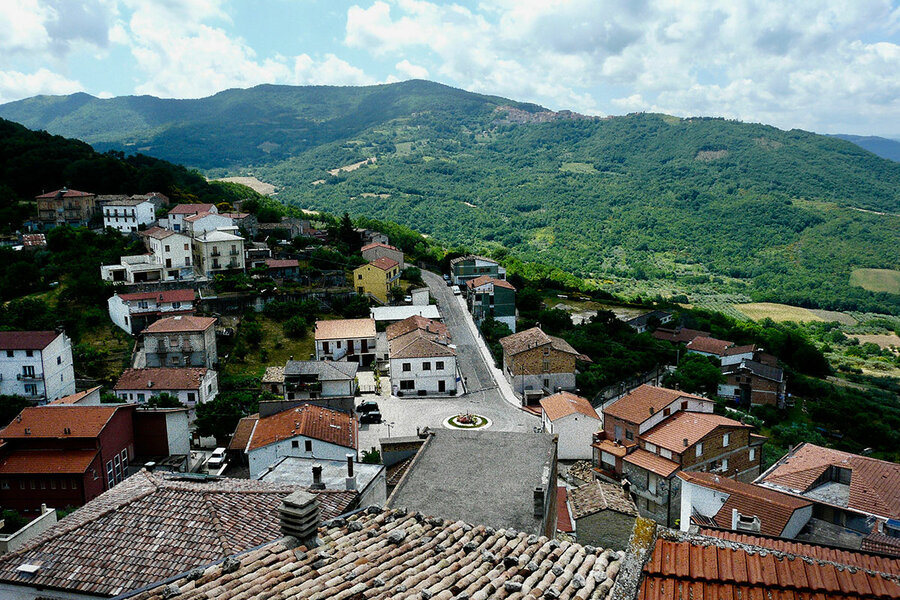Saving ‘our way’: How young Italians are preserving their rare dialect
Loading...
| Montemitro, Italy
Tucked deep within the mountainous landscape of Italy’s Molise region, the language of na-našo – a blend of ancient Croatian and the local Italian dialect – has survived since the 16th century in a handful of isolated towns.
But as the local people have moved away and Italian has overtaken na-našo (pronounced “na-nasho”) as their primary language, that heritage has looked near its end.
Why We Wrote This
A story focused onThe number of people who speak “na-našo,” a centuries-old Croatian dialect found in Italy’s Molise region, is dwindling. But young people brought up in the language are determined to see it survive.
Older members of the community have mostly accepted the possibility that their language will die out within the next few decades. But others, particularly in the younger generation, are determined to see their culture preserved. Even though they may not speak na-našo as fluently as their forebears, they are using social media and cultural festivals to promote the language – and its geographical home, including towns like Montemitro – and safeguard their heritage.
“Growing up in a linguistic Croatian minority is unique. ... Our language is something to be preserved,” says Marco Romagnoli, a 22-year-old resident of Montemitro and a founder of Discover Montemitro, an Instagram account and blog. “We want to preserve, conserve, and pass down this beautiful language.”
Tucked deep within the mountainous landscape near the Adriatic Coast in southern Italy, a language and a culture dating back 500 years are at risk of disappearing.
Roughly 1,000 people in the towns of Montemitro, San Felice, and Acquaviva Collecroce speak Slavomolisano – or na-našo (pronounced “na-nasho”) as it is known in the language – a blend of ancient Croatian and the local Italian dialect of the Molise region.
Created from the blend of Italian culture and the language spoken by 15th-century Croatian refugees, na-našo, meaning “our way,” and its associated traditions have been passed down for generations. But as the towns’ populations have dwindled over the years and Italian has overtaken na-našo as their primary language, that heritage has looked near its end.
Why We Wrote This
A story focused onThe number of people who speak “na-našo,” a centuries-old Croatian dialect found in Italy’s Molise region, is dwindling. But young people brought up in the language are determined to see it survive.
Older members of the community have mostly accepted the possibility that their language will die out within the next few decades. But others, particularly younger people, are determined to see their culture preserved. Even though they may not speak na-našo as fluently as their forebears, they are a driving force behind efforts to celebrate and conserve their blended heritage.
“Growing up in a linguistic Croatian minority is unique. ... Our language is something to be preserved,” says Marco Romagnoli, a 22-year-old resident of Montemitro and na-našo speaker. He is one of the founders of Discover Montemitro, an Instagram account and blog created by the town’s youths to shed light on Montemitro’s history and culture. “We want to preserve, conserve, and pass down this beautiful language.”
From Croatia to Molise
Na-našo would never have existed if the Ottomans had not invaded the Balkan Peninsula in the 1400s, driving thousands of refugees toward the coast of Croatia and eventually across the sea to Italy. By the end of the 15th century, hundreds had landed along Molise’s coast, according to Giovanni Piccoli, a native of Acquaviva and former professor of Latin, Italian, and history at local universities.
At that time, Montemitro, Acquaviva, and San Felice had been abandoned due to an earthquake in 1456. So “the feudal lords, desperate to repopulate their lands, invited the refugees to inhabit these abandoned towns,” says Mr. Piccoli. After arriving in Molise, these refugees mixed their language with the local one, creating na-našo, and married the cultural and religious practices they had brought with them with local traditions.
But that was centuries ago. Today, the town that is arguably the most active of the three when it comes to speaking na-našo is also the smallest: Montemitro, with only 200 full-time residents. That may be because Montemitro was poorly connected and isolated, which allowed its people to preserve the language for longer, says the Rev. Angelo Giorgetta, a local parish priest.
Even today, Montemitro retains some of that rugged remoteness. The streets encircling the town are unpaved, and tall grass and wildflowers grow in abundance along their sides. Like many in Molise, the people of the towns coexist with the wild landscape, often making their living off the land as farmers.
Until a few decades ago, na-našo was the primary language of the three towns. Mr. Piccoli and Mr. Giorgetta, for example, learned Italian only when they attended elementary school. But na-našo is not taught formally in schools. It was perceived by parents as an obstacle to learning Italian, says Mr. Piccoli, who attempted to set up na-našo education for the towns’ youths between the 1970s and 1990s.
Mr. Piccoli says the decline in the number of speakers is due, in part, to the authorities recognizing them as a linguistic minority only in 1998. “For the Italian state, we did not exist, and teaching our language in public schools was not allowed.”
Shining a light on na-našo
Today, the towns and their people are attempting to make up for lost time.
Some, such as the youths behind Discover Montemitro, communicate their pride in their town and its culture by capturing the ordinary moments of Montemitro’s quiet, unassuming beauty. Others organize associations and host cultural events to safeguard their heritage.
The Discover Montemitro Instagram account is filled with snapshots of the town’s winding stone streets; centuries-old wooden doors, balconies, and doorsteps overflowing with flowers and dripping with succulents; wild cats basking in pockets of sunlight; and laundry strung on clotheslines between buildings.
Photos show that the small, ancient town has a panoramic view of the surrounding valley from around almost every corner; street names are written in both Italian and na-našo; and a smattering of benches in main squares are painted in vibrant colors, with local sayings and poetry verses in Italian and na-našo handwritten across the slats.
The account also shares recipes for local dishes inspired by ancient Croatian cuisine. There’s kolači, a ring-shaped dessert filled with jam and dark chocolate; varak, a dish of boiled legumes and cereals; and džrklje, a dessert of fried dough and anisette.
As for cultural associations and event organizers, Fondazione Agostina Piccoli is perhaps the community’s most prominent. Founded in 1999 to protect the Molise Croatian culture, it holds conferences and exhibits, and publishes a cultural magazine in Croatian and Italian. Last September, the foundation held a three-day forum in Montemitro to deepen young people’s understanding of their culture. It consisted of arts and crafts, discussions, musical performances, and guided tours.
In the summer, on balmy nights loud with the chirp of crickets, the foundation hosts an annual poetry reading competition in which locals read poems written in na-našo to an audience, flexing their artistic mastery of the language.
The towns’ cultural associations also recently banded together to create an artistic residency for Croatian artists with the aim of valorizing their cultural heritage through art. And there are tentative plans to host an artistic residency several times a year to coincide with the towns’ cultural and religious events, says Mr. Romagnoli, the young Montemitro resident. “I view this as a positive thing, not only because it shines a light on my town, but also on the others.”
These cultural efforts have also stretched across the sea to involve Croatia. Three Croatian presidents have visited the towns, most recently in 2018, to acknowledge the link Molise and Croatia continue to share despite five centuries of change.
For members of the younger generation in Montemitro, Acquaviva, and San Felice, partaking in such events means protecting and honoring the legacy of the generations that came before them.
“This heritage was passed down to us from our ancestors hundreds of years ago,” says Mr. Romagnoli. “I don’t want to lose it.”










